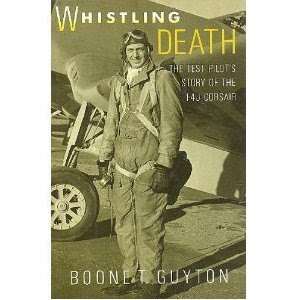The title says it all, yet is doesn't even begin to describe how informative and interesting this book by Boone Guyton, Vought's chief Corsair test pilot during World War Two really is.
Whistling Death: The test pilot's story of the F-4U Corsair.
A Navy Reserve pilot in the lat 1930's Guyton stumbled into a job with Vought just before the war and became intimately involved with the then-experimental Corsair fighter, probably more than any other pilot. And he writes this book with the perspective of both the pilot and the engineer as he tells of the problems involved in testing an aircraft that was so new, so fast and powerful, that the tests frequently took him into totally unexplored territory, several times nearly killing him as he pushed the envelope of high-speed dives and dealt with sudden engine failures as well as routine things like bad weather in the days before all-weather aircraft or even basic airport navigational aids. In fact, one of the stories that he relates is how he crashed the first and only test Corsair on a golf course after getting caught in some weather that likely would have been no problem for a basic instrument-rated General Aviation pilot today and running out of gas. This crash, which set the Corsair program back months, could have resulted in the aircraft never reaching production at all had it been just a little worse as the XF-1 was literally the only Corsair in existence well before the Navy had even taken a token look at it much less accepted it and authorized it's purchase from Vought. (Not mentioned in the book is how a similar crash with Lockheed's only test P-38 during a cross-country air race that it was entered into for publicity's sake nearly cancelled that incredible aircraft as well. But for luck, America nearly lost both of them.)
Guyton relates what it was like trying to find out just what this aircraft was capable of without losing it due to the then-unknown phenomena that affected aircraft as they approached supersonic speed. Spins, high-speed dives, and other criteria that the Navy demanded that new aircraft be tested on several times nearly proved fatal for Guyton because this new aircraft was just so much faster than anything that had been put through these tests before.
Guyton also writes in detail about the design changes between various Corsair variants and the reasons for them, often the result of hard lessons learned by combat pilots trying to use this wonderful new tool against the Japanese.
As a bonus, you get a personal picture of the famous aviator Charles Lindbergh, who became a friend of Guyton's as he was given virtual carte-blanche by the government to show up and fly most any military aircraft whenever he wanted.
It's a fantastic book that I got a year or two ago and I just re-read it a second time and found it to be as enjoyable as it was the first time. If you like history, high-performance aircraft, engineering or flying stories, then you should probably get a copy of this book.

Okay, its now on my Amazon wishlist! The F4U is probably my third-favorite plane of the WW2 era, P-38 being first and the Me-262 being second.
ReplyDeleteThanks for the tip
ReplyDeleteAnd no doubt many a test pilot died testing those planes. Being a test pilot was actually quite risky.
ReplyDeleteEven Richard Bong, our top Ace, died testing the P-80 jet fighter.. the very day we dropped the first Atomic Bomb.
And Rabid.. the P-38 is my first pick. I have quite a few books on it's development as well as the pilots that flew them.